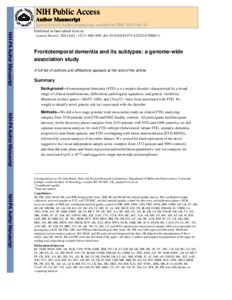Ferrari, Raffaele and Hernandez, Dena G and Nalls, Michael A and Rohrer, Jonathan D and Ramasamy, Adaikalavan and Kwok, John B J and Dobson-Stone, Carol and Brooks, William S and Schofield, Peter R and Halliday, Glenda M and Hodges, John R and Piguet, Olivier and Bartley, Lauren and Thompson, Elizabeth and Haan, Eric and Hernández, Isabel and Ruiz, Agustín and Boada, Mercè and Borroni, Barbara and Padovani, Alessandro and Cruchaga, Carlos and Cairns, Nigel J and Benussi, Luisa and Binetti, Giuliano and Ghidoni, Roberta and Forloni, Gianluigi and Galimberti, Daniela and Fenoglio, Chiara and Serpente, Maria and Scarpini, Elio and Clarimón, Jordi and Lleó, Alberto and Blesa, Rafael and Waldö, Maria Landqvist and Nilsson, Karin and Nilsson, Christer and Mackenzie, Ian R A and Hsiung, Ging-Yuek R and Mann, David M A and Grafman, Jordan and Morris, Christopher M and Attems, Johannes and Griffiths, Timothy D and McKeith, Ian G and Thomas, Alan J and Pietrini, Pietro and Huey, Edward D and Wassermann, Eric M. and Baborie, Atik and Jaros, Evelyn and Tierney, Michael C. and Pastor, Pau and Razquin, Cristina and Ortega-Cubero, Sara and Alonso, Elena and Perneczky, Robert and Diehl-Schmid, Janine and Alexopoulos, Panagiotis and Kurz, Alexander and Rainero, Innocenzo and Rubino, Elisa and Pinessi, Lorenzo and Rogaeva, Ekaterina and George-Hyslop, Peter St and Rossi, Giacomina and Tagliavini, Fabrizio and Giaccone, Giorgio and Rowe, James B and Schlachetzki, Johannes C M and Uphill, James and Collinge, John and Mead, Simon and Danek, Adrian and Deerlin, Vivianna M Van and Grossman, Murray and Trojanowski, John Q and van der Zee, Julie and Deschamps, William and Langenhove, Tim Van and Cruts, Marc and Broeckhoven, Christine Van and Cappa, Stefano F and Ber, Isabelle Le and Hannequin, Didier and Golfier, Véronique and Vercelletto, Martine and Brice, Alexis and Nacmias, Benedetta and Sorbi, Sandro and Bagnoli, Silvia and Piaceri, Irene and Nielsen, Jørgen E and Hjermind, Lena E and Riemenschneider, Matthias and Mayhaus, Manuel and Ibach, Bernd and Gasparoni, Gilles and Pichler, Sabrina and Gu, Wei and Rossor, Martin N and Fox, Nick C and Warren, Jason D and Spillantini, Maria Grazia and Morris, Huw R and Rizzu, Patrizia and Heutink, Peter and Snowden, Julie S and Rollinson, Sara and Richardson, Anna and Gerhard, Alexander and Bruni, Amalia C and Maletta, Raffaele and Frangipane, Francesca and Cupidi, Chiara and Bernardi, Livia and Anfossi, Maria and Gallo, Maura and Conidi, Maria Elena and Smirne, Nicoletta and Rademakers, Rosa and Baker, Matt and Dickson, Dennis W and Graff-Radford, Neill R. and Petersen, Ronald C and Knopman, David and Josephs, Keith A and Boeve, Bradley F and Parisi, Joseph E and Seeley, William W and Miller, Bruce L and Karydas, Anna M and Rosen, Howard and van Swieten, John C and Dopper, Elise G P and Seelaar, Harro and Pijnenburg, Yolande A L and Scheltens, Philip and Logroscino, Giancarlo and Capozzo, Rosa and Novelli, Valeria and Puca, Annibale A and Franceschi, Massimo and Postiglione, Alfredo and Milan, Graziella and Sorrentino, Paolo and Kristiansen, Mark and Chiang, Huei-Hsin and Graff, Caroline and Pasquier, Florence and Rollin, Adeline and Deramecourt, Vincent and Lebert, Florence and Kapogiannis, Dimitrios and Ferrucci, Luigi and Pickering-Brown, Stuart and Singleton, Andrew B and Hardy, John and Momeni, Parastoo
Frontotemporal dementia and its subtypes: a genome-wide association study.
The Lancet Neurology, 13 (7).
686 - 699.
ISSN 1474-4422
(2014)
![[img]](http://eprints.imtlucca.it/2875/1.hassmallThumbnailVersion/nihms599470.pdf)  Preview |
|
PDF (https://www.ncbi.nlm.nih.gov/pmc/articles/PMC4112126/pdf/nihms599470.pdf)
- Submitted Version
Download (849kB)
| Preview
|
Abstract
SummaryBackground Frontotemporal dementia (FTD) is a complex disorder characterised by a broad range of clinical manifestations, differential pathological signatures, and genetic variability. Mutations in three genes—MAPT, GRN, and C9orf72—have been associated with FTD. We sought to identify novel genetic risk loci associated with the disorder. Methods We did a two-stage genome-wide association study on clinical FTD, analysing samples from 3526 patients with {FTD} and 9402 healthy controls. To reduce genetic heterogeneity, all participants were of European ancestry. In the discovery phase (samples from 2154 patients with {FTD} and 4308 controls), we did separate association analyses for each {FTD} subtype (behavioural variant FTD, semantic dementia, progressive non-fluent aphasia, and {FTD} overlapping with motor neuron disease FTD-MND), followed by a meta-analysis of the entire dataset. We carried forward replication of the novel suggestive loci in an independent sample series (samples from 1372 patients and 5094 controls) and then did joint phase and brain expression and methylation quantitative trait loci analyses for the associated (p<5 × 10−8) single-nucleotide polymorphisms. Findings We identified novel associations exceeding the genome-wide significance threshold (p<5 × 10−8). Combined (joint) analyses of discovery and replication phases showed genome-wide significant association at 6p21.3, \{HLA\} locus (immune system), for rs9268877 (p=1·05 × 10−8; odds ratio=1·204 95% \{CI\} 1·11–1·30), rs9268856 (p=5·51 × 10−9; 0·809 0·76–0·86) and rs1980493 (p value=1·57 × 10−8, 0·775 0·69–0·86) in the entire cohort. We also identified a potential novel locus at 11q14, encompassing RAB38/CTSC (the transcripts of which are related to lysosomal biology), for the behavioural \{FTD\} subtype for which joint analyses showed suggestive association for rs302668 (p=2·44 × 10−7; 0·814 0·71–0·92). Analysis of expression and methylation quantitative trait loci data suggested that these loci might affect expression and methylation in cis. Interpretation Our findings suggest that immune system processes (link to 6p21.3) and possibly lysosomal and autophagy pathways (link to 11q14) are potentially involved in FTD. Our findings need to be replicated to better define the association of the newly identified loci with disease and to shed light on the pathomechanisms contributing to FTD. Funding The National Institute of Neurological Disorders and Stroke and National Institute on Aging, the Wellcome/MRC Centre on Parkinson's disease, Alzheimer's Research UK, and Texas Tech University Health Sciences Center.
Actions (login required)
 |
Edit Item |



